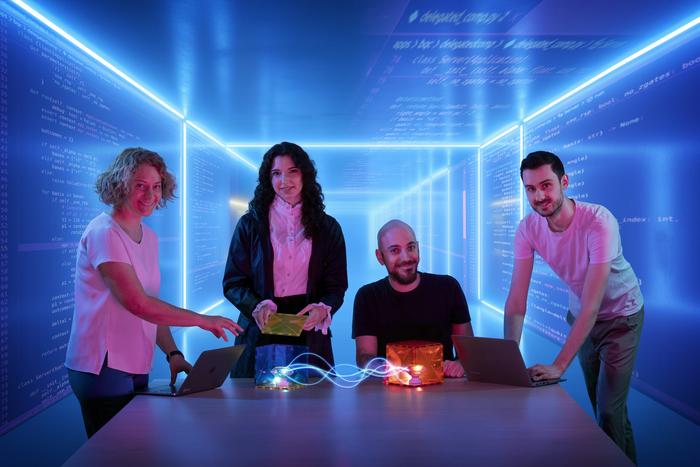In a groundbreaking development that could change the landscape of digital communication, researchers at TU Delft, QuTech, and their international allies have unveiled what is being hailed as the first operating system specifically designed for quantum networks, known as QNodeOS. This ambitious project, detailed in a recent issue of the prestigious journal Nature, signifies an essential leap from theoretical frameworks to practical applications, which many believe could redefine our foundational internet infrastructure in the coming years.
At the core of this innovation lies the potential to revolutionize how we think about networking. Quantum Internet Alliance (QIA) scientists are harnessing the peculiar principles of quantum mechanics—particularly quantum entanglement—to instigate a paradigm shift. Quantum networks differ from classical networks, primarily in how they share information, allowing for instantaneous communication across vast distances, thanks to the magical properties of quantum states. The creation of QNodeOS empowers developers and researchers alike to build applications that track and exploit these unique properties in a user-friendly manner.
Stephanie Wehner, a Professor of Quantum Computer Science at TU Delft’s QuTech and a leading figure behind QNodeOS, emphasized that the system brings quantum network technology one step closer to wider accessibility. “Our aim is to democratize the technology,” she stated, noting that for the first time, it becomes feasible to program and deploy applications on quantum networks without deep technical know-how. Such advancements could open the floodgates for innovative applications that harness the power of quantum communication.
Traditionally, programming quantum network hardware has been an extremely challenging task due to the specific coding required for different experimental setups. QNodeOS seeks to obliterate these barriers by offering a level of abstraction that resembles the user-friendly software found on traditional computing devices. As Mariagrazia Iuliano, a PhD student at QuTech, articulated, this system is akin to the everyday software you might use at home—complex hardware operations are simplified behind an intuitive interface that focuses on functionality rather than the underlying mechanics.
The implications of a fully programmable operating system like QNodeOS extend beyond mere ease of use. The framework enables developers to concentrate on the application logic itself instead of getting bogged down in hardware specifics, fostering an environment ripe for innovation. Bart van der Vecht, another PhD student involved in the project, noted that this architecture—unique in the quantum realm—could lead to applications yet to be conceived, suggesting an exponential growth in potential technological advancements.
Furthermore, QNodeOS is designed to function seamlessly with various types of quantum hardware. Unlike classical processors, which generally run single applications, quantum network applications must operate independently at multiple nodes, reminiscent of client-server architectures employed in cloud computing. The ability to coordinate through both messaging and quantum entanglement introduces a level of complexity; however, QNodeOS effectively navigates these challenges, establishing a robust foundation for future quantum network applications.
Researchers demonstrated the versatility of QNodeOS by deploying it across diverse quantum processor technologies, showcasing the system’s adaptability. Tracy Northup, a Professor at the University of Innsbruck, observed that even contrasting quantum systems—like their ion-trap processors and those based on diamond color centers—could effectively leverage QNodeOS, illustrating its capacity for interoperability. This adaptability is significant, particularly in a field where hardware solutions are still evolving rapidly.
Looking ahead, the creation of QNodeOS is not merely an academic triumph; it represents the confluence of various disciplines, including physics, computer science, and engineering. The QIA team, in their mission to construct a sizable and functional quantum network, recognizes the necessity of establishing a reliable operating system. QNodeOS will serve as a pivotal framework for ongoing explorations, potentially unlocking new realms of research that can drive the development of quantum applications for real-world use.
In terms of ensuring that this technological breakthrough reaches a broader audience, the Quantum Internet Alliance aims to incorporate QNodeOS into the Quantum Network Explorer, QuTech’s quantum internet demonstrator. This initiative will provide an accessible platform for hobbyists, researchers, and developers, enabling them to experiment with and create software tailored for quantum networks. By facilitating this engagement, the QIA hopes to spark creativity and push the boundaries of what is achievable in quantum networking.
Moreover, QNodeOS represents a significant step toward realizing the collective dream of a quantum internet. By paving the way for new applications and making the intricacies of quantum networking approachable, this operating system could foster unprecedented advancements in secure communication, distributed computing, and much more. Experts are keenly aware that the road ahead is still fraught with challenges, but the successful development of this operating system offers a beacon of hope for those invested in the future of both quantum technology and the global internet infrastructure.
As the project progresses, the implications of QNodeOS will undoubtedly extend far beyond its initial applications. The potential to influence areas ranging from cybersecurity to data processing and cloud computing signifies the broad implications of this research. As we stand on the cusp of a new digital age characterized by quantum technologies, QNodeOS represents more than a single achievement; it marks the beginning of a transformative journey toward integrating quantum mechanics into everyday life and technology.
In conclusion, QNodeOS stands as a testament to human ingenuity and the relentless pursuit of innovation. The collaboration of diverse institutions underlines the importance of interdisciplinary work in tackling complex global challenges. The ongoing explorations in quantum networks fueled by this legendary operating system could allow us to harness the esoteric principles of quantum physics for tools that fundamentally change how we connect, communicate, and collaborate in an increasingly digital world.
Subject of Research: Quantum networking technology
Article Title: An operating system for executing applications on quantum network nodes
News Publication Date: 12-Mar-2025
Web References: https://www.nature.com/articles/s41586-025-08704-w
References: Nature, DOI: 10.1038/s41586-025-08704-w
Image Credits: Studio Oostrum
Keywords
Quantum mechanics, quantum networks, QNodeOS, wireless communication, entanglement, technological innovation, digital communication, computer science, interdisciplinary research, quantum processors.
Tags: accessible quantum technologydemocratizing quantum computingdigital communication advancementsfuture of digital networkinginstantaneous communication in quantum networkspractical applications of quantum mechanicsQNodeOS developmentquantum entanglement in networkingquantum Internet Alliance innovationsquantum networks operating systemtransformative internet infrastructureTU Delft QuTech research





